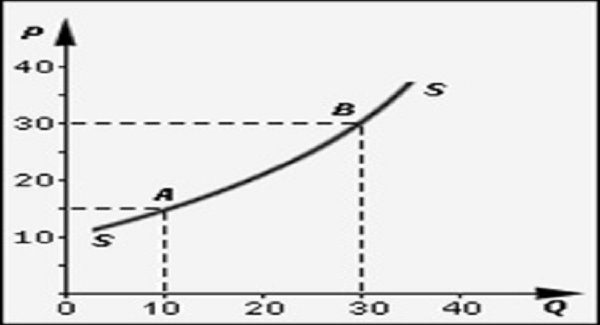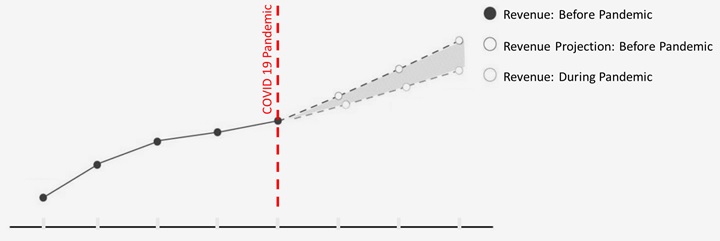October 28, 2020
Due to the COVID-19 pandemic, enterprises adapted to the “new normal” to ensure business continuity. The sudden impact of social distancing and several precautionary measures have put a strain on the economy and impacted every single enterprise across the globe. To maintain business continuity, CEOs, CFOs, COCs, and CIOs launched several immediate and effective cost-cutting measures aimed to reduce the expense level, such as a reduction in IT spending, enforcement of the remote working model and distributed operations, and even reduction in the workforce.
Supply Curve:

Due to the pandemic, leaders were focused to keep up their revenues, without cost management and coordination between business and IT for cost-saving strategies. For instance, the leaders compromised with traditional IT applications and support models to run their business, which are not 100% suitable for the ‘new normal’. This leads to several performance impacts on both the enterprises and the employees.
As enterprises have realized several short-term benefits from their immediate cost-cutting strategies. But this reduced the IT prowess and support models are not capable enough to keep up the business needs and further growth. Hence the enterprises are struggling to run the business in this interim state.
Post COVID 19: Revenue Projection Vs Realization:

Enterprises dealing with these unforeseen challenges have taken a significant toll on the IT budget but haven’t stopped operations entirely. So, it is not too little or too late to adopt new technology to accelerate business and gain revenue.
According to the latest forecast by Gartner, Worldwide IT spending is projected to total $3.4 trillion in 2020, a decline of 8% from 2019, to overcome the challenges in IT cost reduction and maintain steady business growth. This is the right time to regenerate value optimization for long-term benefits through reinvesting and planning for innovation and automation rather than focusing on scaling back large human forces. Also, this is a great opportunity for the leaders to fulfill their digital transformation dream and fill the gaps with the right AI and automation implementation.
Cost Cutting Vs Cost Optimization Approach:

DRYiCETM Software, “the AI foundation for the digital enterprise”, is at the forefront of innovation focused on the “new normal”, helping enterprises to shift gear from cost-cutting to cost optimization to gain back value optimization.
The enterprise can develop a plan to overcome this crunch. Here are seven tips to accelerate the business with reduced IT cost:
Seven Effective and Proven Solutions for Value Optimization
- Reduce the risk of customer attrition and loss of business
The number one challenge is mitigating the risk of declining customer experience and retaining customers while the enterprise is recovering from financial distress due to COVID-19.
With the rise of the AI-enabled cognitive virtual assistant, enterprises can delight customers with continuous, extended, and consistent customer support. This can reduce the human workforce at the service desk, accelerate time to value, provide 24/7 support, reduce operational errors, increase productivity, save money, and so on. Click to know more about, how to reduce the risk of customer attrition and lose business.
- Leverage AI in IT operation functions to reduce business downtime
Due to the reduction in IT spending, leaders are revising their capabilities, especially in the IT operation space to avoid challenges related to availability, scalability, flexibility, and other business outage recovery.
With the rise of zero-touch automation and AI-enabled intelligent automation software, enterprises can bring automation to deliver results in a few hours rather than a few days. This automation software will avoid the risk of losing out on high-value automation candidates, reduce manual efforts, and so on. Click to know more about, how to leverage AI in IT operation functions to reduce business downtime
- Optimize cloud and operation cost
The enterprises operating in the hybrid cloud environment are struggling to track spends on IT assets and services across the business function. Due to the reduced human workforce, managing workloads on multiple cloud platforms becomes paramount.
With the rise of hybrid cloud lifecycle management software, enterprises can take complete control of cloud operations. Through automation, they can govern, provision, monitor, track/reduce cost, manage cloud infrastructure, and so on. Click to know more about, how to optimize cloud and operation cost.
- Enhance employee productivity and IT support cost
Many enterprises from the Big 4 to small-sized ones have responded to the “new normal” and switched to the remote working mode to ensure business continuity. To some extent, they saved some money on office space, maintenance, and supplies, etc., but they realized the hidden challenge in enabling IT support to maintain and increase employee productivity.
With the rise of digital workplace optimization software, enterprises can enable a digital workplace, self-service automation, and auto ticketing to preemptively resolve various common system and application issues through unassisted automation, and so on. Click to know more about, how to enhance employee productivity and reduce IT support cost.
- Make use of the tools delivery platform
Setting up and managing the IT infrastructure is expensive and especially tedious during a crisis. The IT team’s goal is to run a stable environment to prevent business outages. But they can't achieve the goal due to several reasons such as shortage of tool subject matter experts, challenges around tool licensing and maintenance cost, environment scalability, regulatory and process compliance, cumbersome processes for tool deployment, and regular patching/upgrade across all layers in the IT environment.
With the rise of the business-ready hosted platform, and tools across all layers in the IT ecosystem, enterprises can simplify and transform IT operations with a plug-and-play mechanism along with support services to consume it on a pay-per-use model, and so on. Click to know more about, how to make use of tools delivery platforms.
- Transforming IT service delivery with a comprehensive model
The distributed working model brings a new challenge to the enterprises on how to allow employees to access services on the go. The management is responsible to connect suppliers and consumers in a centralized marketplace and keep the momentum to spin the business without any process and service delays.
With the rise of cloud-native catalog aggregation and fulfillment orchestration software, enterprises can enable the users and vendors to access a unified marketplace for requisition and provisioning of services and self-service capabilities to boost the overall efficiency through automated fulfillment routing, and so on. Click to know more about, how to transform IT service delivery with a comprehensive model.
- Enforce unified data-driven business decisions
The “new normal” brings a new challenge in the inventory model, with the reduced spending and complex IT landscape. Enterprises are struggling to aggregate and reconcile billing data. Business decisions are adversely impacted due to the distributed approach toward data collection and analysis. The inability to transform data into actionable insights that inform strategic and business decision-making led to delayed and ineffective decisions. Specifically, in the distributed and managed service environment, a lack of validated data for measuring billable leads to billing conflicts.
With the rise of the robust computational engine, enterprises can transform data into business intelligence. This business intelligence from multiple sources can derive the continuous improvement of upstream and downstream applications with the most accurate and recent data, lower the cost of managing data by de-duplicating data records, get visibility on data governance with standardization, and so on. Click to know how to enforce unified data-driven business decisions.
The Focal Point
Many enterprises managed to operate their business under pandemic crises with several cost-saving strategies. The crucial part is beyond business survival; leaders should position and support the business to succeed in the new reality. Instead of ad hoc, siloed, and spontaneous decisions, CEOs, CFOs, COCs, and CIOs should define the strategies to accelerate business for long-term success by investing in digital transformation through future-proof automation software products.

Senthil Kumar
He is passionate and keen to remain knowledgeable about IT infrastructure, Artificial Intelligence (AI), Automation, Neural nets, Machine Learning (ML), Natural Language Processing (NLP), Image Processing, Client Computing, Blockchain, and Public/Private Clouds. His research interest circles around stack solutions to enterprise problems.
Kumar has a MS in Software Engineering (SE) along with several technical certifications like MIT’s Artificial Intelligence (AI), Machine Learning (ML- Information Classification), Service Oriented Architecture (SOA), Unified Modeling Language (UML), Enterprise Java Beans (EJB), Cloud and Blockchain, etc.









